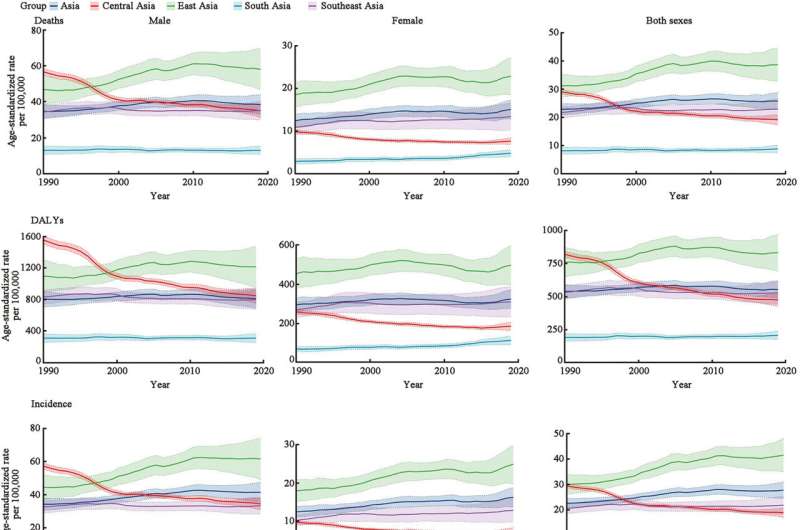This article has been reviewed according to Science X's editorial process and policies. Editors have highlighted the following attributes while ensuring the content's credibility:
fact-checked
peer-reviewed publication
proofread
The rising burden of respiratory tract cancer in Asia

A broad range of genetic and environmental factors can influence the progression of respiratory cancer, making it a diverse disease. According to a prior study of the Global Burden of Diseases, Injuries, and Risk Factors Study (GBD), tracheal, bronchus, and lung (TBL) cancer and larynx cancer cases and fatalities increased globally over the past 10 years.
The higher rates of cancer health outcomes between affected populations (age-standardized incidence) and mortality rates associated with laryngeal and TBL malignancies have raised concerns. Although statistical data on respiratory cancer vary between the Eastern and Western regions, it is still the most common cause of cancer-related deaths globally.
Variations in the incidence and mortality rates of respiratory cancers may result from geographically divergent and distinct individuals and different environmental exposures in the Eastern and Western regions. The differences between the East and the West suggest that respiratory tract cancers in Asian nations should be investigated and more relevant suggestions should be offered.
Now, for the very first time, a team of scientists led by Dr. Jianxing He from the Department of Thoracic Surgery and Oncology at the First Affiliated Hospital of Guangzhou Medical University, the State Key Laboratory of Respiratory Disease, the National Clinical Research Center for Respiratory Disease, and the Guangzhou Institute of Respiratory Health, China, aimed to investigate the risks and prevalence of TBL and larynx cancer in Asian, regional, and national populations spanning two decades, i.e., from 1990 to 2019.
Dr. He states, "We herein describe the burdens of respiratory tract cancers (i.e., TBL and larynx cancers) and their attributable risk factors in 33 Asian countries from 1990 to 2019 according to sex, Asian region, and socio-demographic index (SDI) and attempt to provide clues to resolve the problems caused by the main risk factors for respiratory tract cancers in Asia."
The article was published in the Chinese Medical Journal Pulmonary and Critical Care Medicine.
The team of investigators initially obtained data from the GBD website to analyze the overall incidence of respiratory cancer in 33 Asian countries. Using the GBD database 2019, the researchers examined the incidence, mortality, disability-adjusted life years (DALYs), years of life lost (YLLs), and years lived with disability (YLDs) due to TBL and larynx cancers.
For three measures—death, disability-adjusted life years (DALYs), and incidence—the researchers evaluated the age-standardized rates for TBL cancer in Asia, which were modified for smoking and SDI, both separately and together, between 1990 and 2019.
The findings of this study revealed that while the age-standardized incidence rate of laryngeal cancer expanded, the age-standardized incidence and mortality rates for TBL cancer in Asia decreased between 2010 and 2019. The team also compared their GBD data with a previous GBD study spanning from 2010 to 2019, which was published in The Lancet Respiratory Medicine. "Our present results showed that the disease burden for TBL and larynx cancer in Asia was higher than the global level," Dr. He remarks.
The results indicated that over the past 10 years, age-standardized incidence rates for TBL cancer have decreased globally by 7.4%, and the age-standardized incidence rates for larynx cancer have decreased by 3.0% in males. However, age-standardized incidence rates for TBL cancer and larynx cancer in females fell by 0.5% and 0.9%, respectively, over the same period.
According to the GBD 2019 analysis, the research team ranked smoking as the primary specific risk factor for TBL and larynx cancers in Asia. The research findings also revealed that for both sexes combined in Asia and globally, atmospheric air pollution was ranked as the second highest risk factor in TBL cancer, and in laryngeal cancer, the second highest risk factor was the consumption of alcohol in both sexes, followed by occupational exposure to sulfuric acid.
The researchers made adjustments to SDI and smoking for the analysis of DALYs, age-standardized death, and incidence rates between 1990 and 2019 for TBL cancer, and it was observed that, especially in males in Central Asia, smoking and SDI had a significant impact on TBL cancer risk.
Dr. J. He says, "Among the Asian regions included in the present study, East Asia had the highest age-standardized rates (death, DALYs, and incidence) for TBL cancer from 1990 to 2019. Since 2010, however, these rates have started to decline in males but have increased in females."
Finally, Dr. He and the team emphasize the importance of the study, concluding, "Our study highlights the need for expanded smoking-control programs and regulating other risk factors for TBL and larynx cancer in Asia to mitigate their impact and provides insights to help policymakers promote the early prevention and treatment of these cancers and improve public health."
More information: Ran Zhong et al, Asian, regional, and national burdens of respiratory tract cancers and associated risk factors from 1990 to 2019: A systematic analysis for the global burden of disease study 2019, Chinese Medical Journal Pulmonary and Critical Care Medicine (2023). DOI: 10.1016/j.pccm.2023.11.002





















